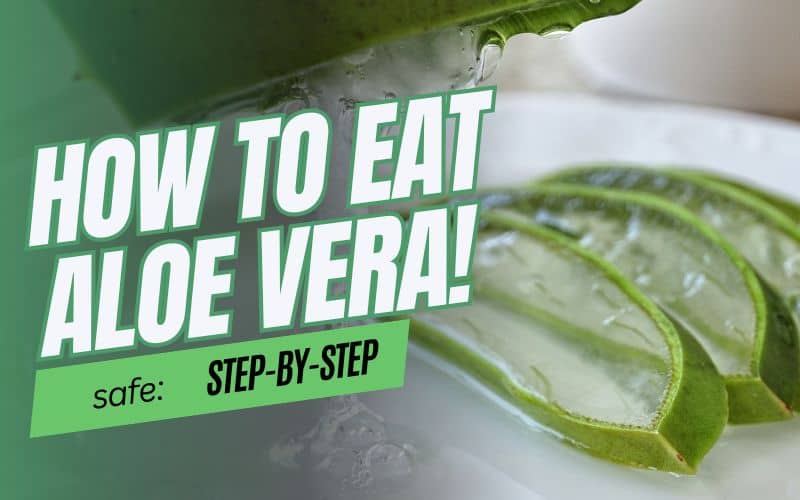Aloe vera, a succulent plant known for its soothing gel used topically for burns and wounds, also offers surprising internal benefits. Consumed in moderation, aloe vera gel can be a healthy addition to your diet.
This guide explores the world of edible aloe vera, taking you through safe preparation methods, delicious ways to incorporate it into your meals, and potential health benefits.
Key points:
- Only consume the clear gel inside the aloe vera leaf, not the yellow latex or outer rind.
- Thoroughly wash and remove all traces of aloin (the bitter yellow latex) to avoid stomach discomfort.
- Aloe vera has a mild flavor that blends well with fruits and vegetables in smoothies, salads, and juices.
- Start with small portions of aloe vera and monitor your body’s reaction due to its potential laxative effects.
- Consult your doctor before consuming aloe vera if you are pregnant, breastfeeding, or taking medications.
Best Aloe Vera Juice: Find Your Perfect Match!

Understanding Edible Aloe Vera
The aloe vera plant consists of thick, fleshy leaves with a spiky exterior. The clear gel found inside the leaves is the edible part. However, the yellow latex lining the inner leaf and the outer rind are not for consumption.
Why Remove Aloin?
Aloin, a bitter compound found in the latex, can cause stomach cramps, diarrhea, and other digestive issues. While some commercially prepared aloe vera products have the aloin removed, it’s crucial to be cautious when consuming fresh aloe vera.

Preparing Aloe Vera for Consumption
Here’s a step-by-step guide on preparing fresh aloe vera for safe eating:
- Select a healthy leaf: Choose a plump, firm leaf from a mature aloe vera plant.
- Wash thoroughly: Rinse the leaf under running water to remove dirt and debris.
- Trim the edges: Cut off the spiky edges using a sharp knife.
- Slice the leaf: Stand the leaf upright and carefully slice off one side of the rind using a sharp knife or vegetable peeler.
- Scoop out the gel: With a spoon, scoop out the clear gel from the inside of the leaf.
- Remove the aloin: Rinse the gel thoroughly under running water to remove any traces of the yellow latex (aloin). You may repeat this process several times if necessary.

Creative Ways to Eat Aloe Vera
The mild flavor of aloe vera gel makes it a versatile ingredient. Here are some ideas for incorporating it into your diet:
In Smoothies:
- The gel’s jelly-like texture adds thickness to smoothies.
- Combine aloe vera with fruits like pineapple, mango, or berries to mask any bitterness.
- Include vegetables like spinach or kale for a nutritional boost.
Tip: Freeze aloe vera cubes beforehand for a refreshing smoothie experience.
In Salads:
- Dice the gel into small cubes and toss them into salads for a unique and healthy crunch.
- Pair aloe vera with other refreshing ingredients like cucumber, watermelon, and mint.
- For a savory twist, try adding aloe vera to a quinoa or brown rice salad.
In Juices:
- Aloe vera can be added to green juices for a touch of sweetness and a boost of vitamins.
- Combine it with cucumber, celery, and apple for a refreshing and detoxifying juice.
Tip: Start with a small amount of aloe vera in your juice and gradually increase the quantity as your taste buds adjust.

Potential Health Benefits of Consuming Aloe Vera
While research is ongoing, some studies suggest that consuming aloe vera may offer a range of health benefits:
- Aiding digestion: Aloe vera’s prebiotic properties may promote healthy gut bacteria and aid digestion [1].
- Supporting blood sugar control: Studies suggest aloe vera may help regulate blood sugar levels [2].
- Boosting immunity: Aloe vera contains vitamins and antioxidants that may support the immune system [3].
Disclaimer: It is important to note that these are potential benefits, and further research is needed to confirm their efficacy.

Important Considerations When Eating Aloe Vera
While generally safe for most people in moderation, aloe vera can have side effects:
- Laxative effects: Aloe vera has laxative properties, so start with small amounts and monitor your body’s reaction.
- Drug interactions: Aloe vera may interact with certain medications. Consult your doctor before consuming aloe vera if you are taking any medications.
- Pregnancy and breastfeeding: Avoid consuming aloe vera if you are pregnant or breastfeeding due to potential health risks.

Conclusion: Aloe Vera Eating Guide
Aloe vera offers a unique way to add a touch of the exotic to your diet while potentially reaping some health benefits. Remember, moderation is key.
By following the preparation steps and incorporating aloe vera creatively into your meals, you can enjoy this versatile ingredient safely and deliciously.
Easy Aloe Vera Juice Recipe – Fresh & Healthy🌵😁
FAQs
Q: Where can I buy aloe vera leaves?
A: Aloe vera plants are readily available at many garden centers and some grocery stores.
Q: How long can I store aloe vera gel?
A: Store leftover aloe vera gel in an airtight container in the refrigerator for up to a week.
Q: Can I use store-bought aloe vera juice for consumption?
A: Use caution with commercially prepared aloe vera juice. Ensure the label specifies it’s for internal consumption and that the aloin has been removed. It’s generally recommended to prioritize fresh aloe vera for maximum control over preparation.
Q: How much aloe vera is safe to consume?
A: There is no one-size-fits-all answer. Start with a small amount, like 1 tablespoon of gel, and monitor your body’s reaction. Gradually increase the quantity if you experience no side effects.
Q: Are there any alternative ways to consume aloe vera?
A: Limited research suggests topical application of aloe vera gel may offer benefits for wound healing and skin health [4].
However, more research is needed, and consulting a doctor is recommended before using aloe vera for topical purposes.
We hope this Aloe Vera Eating Guide empowers you to explore the world of this unique ingredient. Remember, always prioritize safety and consult your doctor if you have any concerns before consuming aloe vera.





